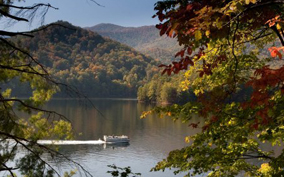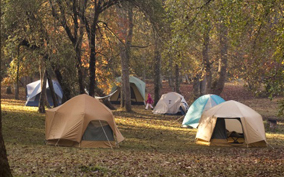Scenic drives on North Carolina’s national forests show off fall foliage

Relish autumn’s hues while boating on Santeetlah Lake in the Cheoah Ranger District, Nantahala National Forest.
Photo credit: U.S. Forest Service
Posted by: Jane Knowlton, WO Office of Communication, U.S. Forest Service
As the days turn cooler, the perennial treat of fall’s panorama of spectacular colors offers many opportunities to enjoy the pageantry on the Nantahala and Pisgah National Forests in North Carolina.
Fall Foliage in Western North Carolina - 2015 showcases the forest’s scenic drives and popular locations. It also offers pictures of scenes from the forests and provides directions to enjoy the kaleidoscope of glorious leaf colors that North Carolina has to offer. The webpage also includes links to webcams, maps and other useful online sources.
“Western North Carolina is such a popular place to visit we actually have two peak seasons for visitation in the Pisgah and Nantahala National Forests,” said Stevin Westcott, public affairs officer for the National Forests in North Carolina. “After summer season peaks, we receive a second wave of visitation in the autumn as leaf-peepers migrate to the mountains to marvel at the wondrous, colorful displays of the Blue Ridge Mountains.”
This year, visitors can also use the new NCtrails.org web application for planning their fall foliage adventures. The searchable web application (web app) offers details on three popular trail systems in western North Carolina, as well as state-of-the-science information on the region’s forests.
Prospective visitors and fall leaves enthusiasts can track the progression of fall’s colorful display in Western North Carolina wilderness areas via two webcams in the Cold Mountain, Shining Rock Wilderness and the Joyce Kilmer Wilderness Area.
The website provides descriptions of the types of mountain trees that visitors will see during peak season at high, middle and low elevations. For example, the Cherohala Skyway in Graham County enables travelers to enjoy a variety of colorful, high-elevation trees in late September.
Prominent trees in the South that turn brilliant colors include tulip poplar (yellow), hickory species (red), flowering dogwood (red), blackgum (scarlet) and numerous oaks (reds, yellow, scarlet). Evergreen trees such as pitch pine, as well as the abundant great rhododendron, provide a green backdrop interspersed with the colorful trees.
Where do all the colors come out? When temperatures cool in autumn, chlorophyll starts to degrade allowing the hidden pigments of deciduous trees to provide a rich, colorful display. This rich display typically starts at the highest elevation in late September and early October gradually progressing to the lowest elevation by late October and early November.
Remember, whether in a vehicle, riding a bike or taking a hike, autumn is always a great time to visit your national forests. Throughout the country, you can view the brilliant red, orange and yellow leaves as each region beckons with a different pallet of vibrant colors.
| Share |  |
Tweet |
|---|


High in vitamin C, rose hips are an important food source for forest birds and mammals.
Photo credit: U.S. Forest Service/ Edna Rey-Vizgirdas


